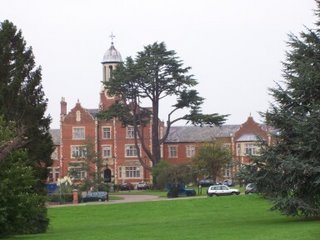Sunday, October 15 (approximately ten miles)
 Monument to Dr. Samuel Parr, LL.D., and his first wife, Jane Parr, in the south chancel of Holy Trinity Church, Hatton.
Monument to Dr. Samuel Parr, LL.D., and his first wife, Jane Parr, in the south chancel of Holy Trinity Church, Hatton.Walking out from his consular home at 10 Landsdowne Crescent, Nathaniel Hawthorne left behind the white Victorian terraces of Leamington Spa and struck out into the surrounding countryside to visit some of the old churches. The old churches always impressed him with their aspect of “hoar antiquity,” and he liked to meditate on the picturesque changelessness of “the mother country.” In rural Whitnash, outside Leamington, he saw life going on as he imagined it had gone on, changelessly, for hundreds of generations: “The man who died yesterday or ever so long ago walks the village street today, and chooses the same wife that he married a hundred years since, and must be buried again tomorrow under the same kindred dust that has already covered him half a score of times. The stone threshold of his cottage is worn away with his hobnailed footsteps, shuffling over it from the reign of the first Plantagenet to that of Victoria.” England is delightfully quaint and picturesque, but better, Hawthorne believes, is the innovative spirit of America, the restless commitment to progress and change.
From Whitnash, Hawthorne continued on to Hatton, to visit the church which Dr. Parr had served for so many years.
Hatton, so far as I could discover, has no public-house, no shop, no contiguity of roofs (as in most English villages, however small), but is merely an ancient neighborhood of farm-houses, spacious, and standing wide apart, each within its own precincts, and offering a most comfortable aspect of orchards, harvest-fields, barns, stacks, and all manner of rural plenty. It seemed to be a community of old settlers, among whom everything had been going on prosperously since an epoch beyond the memory of man; and they kept a certain privacy among themselves, and dwelt on a crossroad, at the entrance of which was a barred gate, hospitably open, but still impressing me with a sense of scarcely warrantable intrusion...
Emerging from the by-road, and entering upon one that crossed it at right angles and led to Warwick, I espied the church of Dr. Parr. Like the others which I have described, it had a low stone tower, square, and battlemented at its summit: for all these little churches seem to have been built on the same model, and nearly at the same measurement, and have even a greater family-likeness than the cathedrals. As I approached, the bell of the tower (a remarkably deep-toned bell, considering how small it was) flung its voice abroad, and told me that it was noon. The church stands among its graves, a little removed from the wayside, quite apart from any collection of houses, and with no signs of a vicarage; it is a good deal shadowed by trees, and not wholly destitute of ivy...
Hawthorne peeked in one of the windows and imagined Dr. Parr’s congregation asleep in their pews as the learned doctor preached:
Those who slept under Dr. Parr's preaching now prolong their nap, I suppose, in the churchyard round about, and can scarcely have drawn much spiritual benefit from any truths that he contrived to tell them in their lifetime. It struck me as a rare example (even where examples are numerous) of a man utterly misplaced, that this enormous scholar, great in the classic tongues, and inevitably converting his own simplest vernacular into a learned language, should have been set up in this homely pulpit, and ordained to preach salvation to a rustic audience, to whom it is difficult to imagine how he could ever have spoken one available word.
 The church I found in Hatton was not, in every respect, the church that Hawthorne found in the 1850’s. The church was extensively rebuilt in 1888, and only the tower (with Dr. Parr’s bells inside) remains from earlier times. Unlike Hawthorne, I found the church unlocked, and the vicar and curate (Dr. Parr’s successors) engaged in a deep theological discussion in the nave. They kindly invited me to look around, and I was able to find Dr. Parr’s own monument in the south chancel. The inside of the tower (the “ringing chamber”) was full of other monuments, many with inscriptions composed by Dr. Parr himself.
The church I found in Hatton was not, in every respect, the church that Hawthorne found in the 1850’s. The church was extensively rebuilt in 1888, and only the tower (with Dr. Parr’s bells inside) remains from earlier times. Unlike Hawthorne, I found the church unlocked, and the vicar and curate (Dr. Parr’s successors) engaged in a deep theological discussion in the nave. They kindly invited me to look around, and I was able to find Dr. Parr’s own monument in the south chancel. The inside of the tower (the “ringing chamber”) was full of other monuments, many with inscriptions composed by Dr. Parr himself.Down the Birmingham Road from the church, in the direction of Warwick, I found the public house that Hawthorne missed, The Waterman Pub, which stands at the top of a long slope leading down to the Grand Union Canal. At The Waterman, I had an excellent pint of local ale—Arkwright’s Special Bitter from the Slaughterhouse Brewery in Warwick.

 Hawthorne would perhaps be surprised to find that both Whitnash and Hatton have been developed and suburbanized in recent years. In Hatton, an entire new suburban development has grown up around the old county asylum, which closed in the 1990s and was converted to condominiums (top photograph at left). He would have been astounded by the traffic speeding past on the A4177 to Birmingham. He might have been more at home watching the longboats navigate the twenty-one locks on the Grand Union Canal at Hatton. The canal was opened in 1800, and the longboats still move through the locks at a nineteenth-century pace. For a boat going downstream (as this one is, heading toward Warwick), the level of the water in each lock must be raised and then lowered. Although the boats are motorized now, the locks are still opened and closed by hand (in this photograph, you might be able to see a woman in a green sweatshirt holding the lock open).
Hawthorne would perhaps be surprised to find that both Whitnash and Hatton have been developed and suburbanized in recent years. In Hatton, an entire new suburban development has grown up around the old county asylum, which closed in the 1990s and was converted to condominiums (top photograph at left). He would have been astounded by the traffic speeding past on the A4177 to Birmingham. He might have been more at home watching the longboats navigate the twenty-one locks on the Grand Union Canal at Hatton. The canal was opened in 1800, and the longboats still move through the locks at a nineteenth-century pace. For a boat going downstream (as this one is, heading toward Warwick), the level of the water in each lock must be raised and then lowered. Although the boats are motorized now, the locks are still opened and closed by hand (in this photograph, you might be able to see a woman in a green sweatshirt holding the lock open).


1 comment:
Of course, the lock only needs to be filled if it has been left empty.
If you are fortunate enough to arrive at a lock through which another boat has just come in the opposite direction, it will already be in the correct state for you.
A busy lock in the 19th century would seldom have needed to fill or empty without a boat inside.
Post a Comment